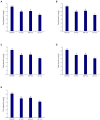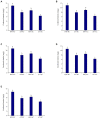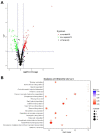Heat wave event facilitates defensive responses in invasive C3 plant Ambrosia artemisiifolia L. under elevated CO2 concentration to the detriment of Ophraella communa
- PMID: 35968104
- PMCID: PMC9363847
- DOI: 10.3389/fpls.2022.907764
Heat wave event facilitates defensive responses in invasive C3 plant Ambrosia artemisiifolia L. under elevated CO2 concentration to the detriment of Ophraella communa
Abstract
To predict and mitigate the effects of climate change on communities and ecosystems, the joint effects of extreme climatic events on species interactions need to be understood. Using the common ragweed (Ambrosia artemisiifolia L.)-leaf beetle (Ophraella communa) system, we investigated the effects of heat wave and elevated CO2 on common ragweed growth, secondary metabolism, and the consequent impacts on the beetle. The results showed that elevated CO2 and heat wave facilitated A. artemisiifolia growth; further, A. artemisiifolia accumulated large amounts of defensive secondary metabolites. Being fed on A. artemisiifolia grown under elevated CO2 and heat wave conditions resulted in the poor performance of O. communa (high mortality, long development period, and low reproduction). Overall, under elevated CO2, heat wave improved the defensive ability of A. artemisiifolia against herbivores. On the other hand, enhanced adaptability to climatic changes may aggravate invasive plant distribution, posing a challenge to the control of invasive plants in the future.
Keywords: Ophraella communa; biological invasions; climate change; common ragweed; herbivore; invasive plant; secondary metabolite.
Copyright © 2022 Tian, Ma, Zhao, Zhang, Gao, Tian, Chen, Guo and Zhou.
Conflict of interest statement
The authors declare that the research was conducted in the absence of any commercial or financial relationships that could be construed as a potential conflict of interest.
Figures





References
-
- Ainsworth E. A., Rogers A. (2007). The response of photosynthesis and stomatal conductance to rising [CO2]: mechanisms and environmental interactions. Plant Cell Environ. 303, 258–270., PMID: - PubMed
-
- Bauweraerts I., Ameye M., Wertin T. M., McGuire M. A., Teskey R. O., Steppe K. (2014). Water availability is the decisive factor for the growth of two tree species in the occurrence of consecutive heat waves. Agric. For. Meteorol. 189-190, 19–29. doi: 10.1016/j.agrformet.2014.01.001 - DOI
-
- Bryant J. P., Chapin F. S., Klein D. R. (1983). Carbon/nutrient balance of boreal plants in relation to vertebrate herbivory. Oikos 40, 357–368. doi: 10.2307/3544308 - DOI
-
- Buse A., Good J. E. G., Dury S., Perrins C. M. (1998). Effects of elevated temperature and carbon dioxide on the nutritional quality of leaves of oak (Quercus robur L.) as food for the winter moth (Operophterabrumata L.). Funct. Ecol. 12, 742–749. doi: 10.1046/j.1365-2435.1998.00243.x - DOI
LinkOut - more resources
Full Text Sources
Miscellaneous

